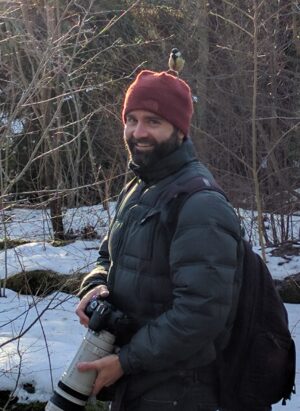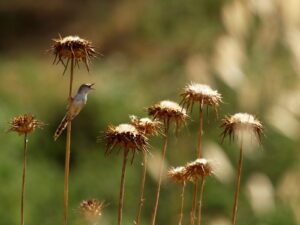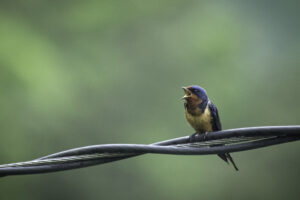Heard that Bird: Creanza Lab develops free curriculum to teach birdsong identification

Since 2020, a question has nagged at Nicole Creanza: What type of bird is singing in the background of Taylor Swift and Bon Iver’s song “Exile”? Creanza, associate professor of biological sciences, is an expert in the evolution of human language and bird songs, but she also enjoys trying to identify popular music by ear.
Combining both of those interests, the Creanza Lab created an educational game show called “Heard That Bird” for students in grades 6-12. While watching the video, participants play along with Creanza, one of her doctoral students, and one of her undergraduate students to identify which birds they can hear in various pop culture media, such as movies, music, or video games.
“Players get an insider’s look at the tools of a birdsong expert,” Creanza said. “They see how we visualize sounds with spectrograms and then interpret that frequency and pattern to determine which bird species is singing.”

The game is part of a free lesson plan Creanza co-developed with education studio Galactic Polymath. Created by songbird researcher Matt Wilkins, BA’06 in Spanish linguistics and ecology, evolution, and organismal biology, Galactic Polymath helps scientists translate their work for middle- and high-school classrooms. The lesson plan is currently available to students and educators nationwide.
The unit relates to a larger research project Creanza is conducting through a National Science Foundation grant she received last August. Creanza said that learned behaviors like birdsongs are important to study as they can reveal information about evolution on a larger scale and about the creation of new species. However, it is often difficult to translate complex behaviors into measurements that can be compared between species. With the NSF funding, Creanza is examining how birds’ songs and genes change over time, and how quantifying these changes helps us understand how the evolution of songs relates to the formation of new bird species.
The lesson plan materials include the game show and presentation, providing an interactive and fun way for teachers to help students learn about the science of bird identification. The unit is part of the NSF’s “Broader Impacts” initiative, which supports researchers in translating their cutting-edge work for the public.

“With this unit, we’re trying to de-mystify wildlife acoustics,” said Wilkins, who acts as the game show’s host. “There are so many natural sounds going on around us all the time, and there’s a story behind each one. When we start paying attention, we might notice crows calling in the establishing shot of a TV drama and wonder, ‘Why did they feature that bird and not a cardinal?’ The answer is because our brains perceive crows as foreboding and cardinal songs as peaceful.”
Creanza said she thinks learning how to identify birds by their sounds is not only a fun hobby and great opportunity for building critical thinking skills, but it also connects us to our environment and can promote mental health.
“We often think that biodiversity is a distant or exotic thing, but actually it’s all around us—whether we’re in the city or out in the country,” Creanza said. “Paying closer attention to bird sounds and trying to figure out who’s singing is a gateway to building a closer connection to our environment, and studies show that being closer to nature can benefit mental health.”

Creanza’s NSF-funded research depends heavily on birdsong recordings submitted by bird enthusiasts around the world, so she is hoping the new lesson plan will help inspire the next generation on a lifelong exploration of natural sounds.
“We want students to get curious about their acoustic environment, even when they’re inside,” Creanza said. “Hopefully that will be a gateway for exploring the outdoors.”
With all that said, what species of bird is singing in that Taylor Swift song?
“We’re not totally sure,” Creanza admits. “We think it’s a type of warbler. It’s possible that they may have altered the birdsong sample during production, so the conclusive evidence to unravel this mystery ultimately lies with the sound-mixer on ‘Exile.’”
